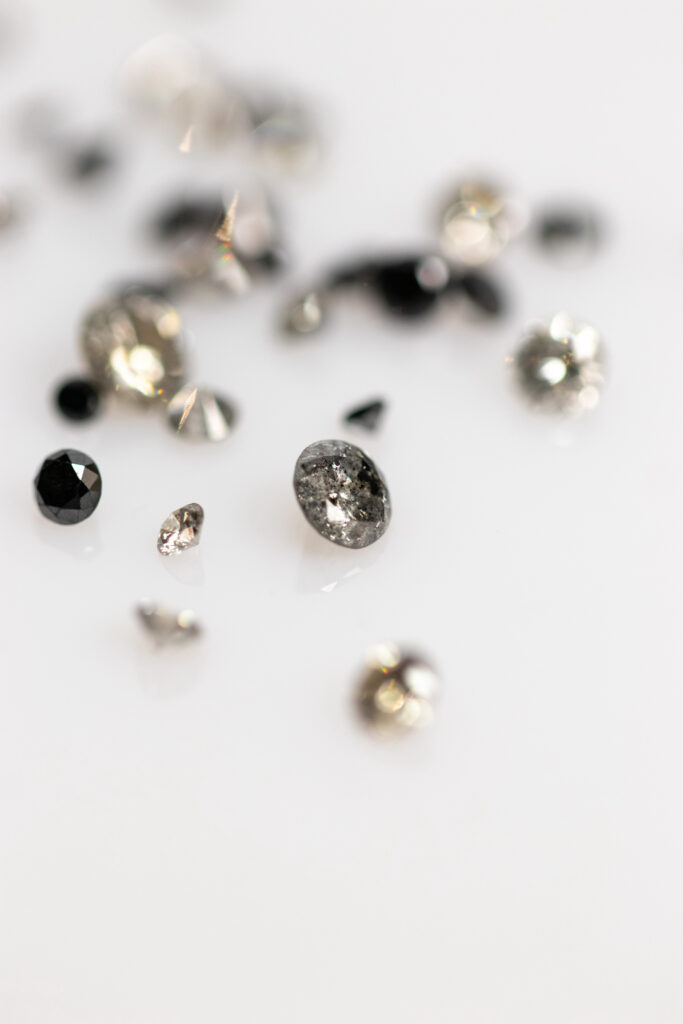Salt and pepper diamonds are regular diamonds that are littered with inclusions and flaws but does this unique style cost more than clear diamonds?
Salt and pepper diamonds are less expensive than clear, or ‘flawless’ diamonds, simply because they’re less brilliant, darker, and have a lower refractive index. They’re not as ‘pretty’ as regular diamonds, but they are unique in their own right.

Read on to learn more about salt and pepper diamonds, why they have that name, and where they come from.
We’re Talking About Diamonds, Not Condiments
It takes billions of years for a natural diamond to form from pure carbon while being subjected to immense heat and pressure. This process can be made imperfect as a result of interruptions by invasive elements and foreign bodies.
When a diamond is forming, there are many things that can interrupt the process, from trace elements like nitrogen, boron, and hydrogen to air bubbles and minute fractures. However, it is extremely rare to find a diamond with no inclusions – they almost don’t exist at all.
That’s why a flawless diamond, or as flawless as possible, carries with it such an exorbitant value. Throughout history, we’ve seen diamonds that have boasted multi-hundred-million-dollar values, despite being something that can fit in the palm of your hand.
Although, that isn’t to say that diamonds with flaws and inclusions are worthless – it’s quite the opposite, in fact. When a diamond forms with a high density of inclusions, it can become known as a salt and pepper diamond.
This naming convention originates from the fact that the diamond literally looks as though it’s a mixture of salt and pepper. It’ll be a relatively clear diamond but dashed through with black and grey inclusions that permeate the entire stone.
As a result of this high concentration of inclusions, a salt and pepper diamond will have a very hard time reflecting light. Of course, one of the most attractive aspects of a diamond is that it refracts light in a unique way, creating that sparkle that diamonds are so well known for.
Therefore, it stands to reason that a salt and pepper diamond will be much less popular a choice than a regular diamond, for this one particular reason. With that in mind, it becomes easy to see why a salt and pepper diamond is also much cheaper than a regular, flawless diamond.
It’s Still A Diamond, But A More Unique One
There are many terms used to describe salt and pepper diamonds, given by the jewelers who sell them. For example, a salt and pepper diamond can be known as smokey, mysterious, wild, and versatile.
At their core, salt and pepper diamonds are the same as regular diamonds, they just have more inclusions. They’re equally as durable, resistant to damage, and they can be cut in the exact same way as a standard diamond.
Although, if the concentration of inclusions is too dense, then the diamond cutter may have issues in producing as clean a finish. However, the molecular integrity of the stone itself isn’t usually compromised in any way.
If there’s one key benefit of a salt and pepper diamond, it’s that almost every single stone is completely unique. There’s often no rule or pattern to the way inclusions work, and they’ll occur differently from one gemstone to the next.
While that might sound expensive, a truly unique diamond, it doesn’t really affect the cost in any way. If you were to purchase a one-carat flawless diamond, and a one-carat salt and pepper diamond, the latter gemstone would cost you a significant amount less.
Furthermore, salt and pepper diamonds can be a more eco-friendly alternative, as they can be lab-grown. It takes mere days to grow a diamond in a laboratory environment, which certainly beats waiting billions of years for one to form naturally.
When a salt and pepper diamond is lab-grown, inclusions are forced into the gemstone as it develops. It’s still a process that guarantees a durable and attractive gemstone, with all the uniqueness of a natural salt and pepper diamond.
This is obviously a key concern for a lot of people, as there’s a strong desire to avoid purchasing conflict diamonds. Although it’s rare that an accredited jeweler will sell conflict diamonds, it is always a risk that can be present when purchasing any diamond.
If the diamond is lab-grown, it’s inherently ethical, and there’s no way it can be a conflict diamond. This is the case for a lot of the salt and pepper diamonds on the market.
